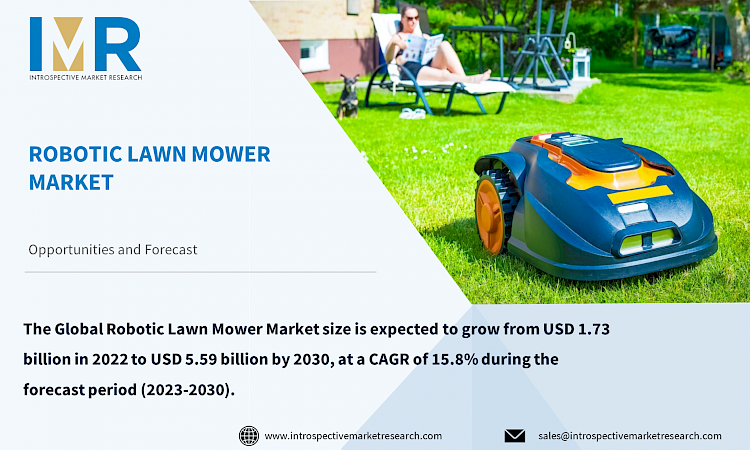
Market Overview:
The Global Robotic Lawn Mower Market size is expected to grow from USD 1.73 billion in 2022 to USD 5.59 billion by 2030, at a CAGR of 15.8% during the forecast period (2023-2030).
A battery-powered, automated, little mower is referred known as a robotic mower. Once the mowing area is defined with boundary wire and the mower is configured, a robotic mower may handle grass-mowing tasks with little time input. The advancement of artificial intelligence (AI) technology has paved the way for mobile robot efficiency. The global market for robotic lawnmowers is being driven by a growing dependence on automation in the commercial sector to reduce operational costs as well as an increased adoption of home robots for various household applications such as cleaning, lawn mowing, and others.
Top Key Players for Robotic Lawn Mower Market:
Alfred K?rcher, AL-KO, Deere & Co., Future Gen Robotics, Hangzhou Favor Robot Technology, Hitachi, Honda Motor Company, Husqvarna, iRobot, LG, Linea Tielle, Mamibot, Milagrow HumanTech, MTD Products, Ningbo NGP Industry, Positec Tool (WORX), Robert Bosch, STIGA, STIHL, The Kobi Company, The SUMEC Corp. (Yard Force), Turflynx, Volta, Wiper Ecorobt (NIKO), Yamabiko Europe (Belrobotics), ZCS, Zhejiang Tianchen Intelligence & Technology, ZICOM, ZIPPER Maschinen, and other major player.
Market Dynamics and Factors for the Robotic Lawn Mower Market:
Drivers:
Increasing demand from households to maintain backyards is the main driver.
The need to save time on lawn maintenance as well as increased expenditure on landscaping, backyard beautification, backyard cookouts, and garden parties are fueling demand for a variety of gardening tools, which is driving the market. Additionally, variables like the developing construction and tourist sectors, as well as people's rising disposable income globally, have an impact on the market. Global demand for robotic lawnmowers is projected to increase as consumers' preferences for energy-efficient systems and the popularity of autonomous technologies that require little user intervention expand.
Opportunities:
Integration of AI and advanced GPS systems in Robotic lawnmowers presents upward growth opportunities.
Emerging technologies like AI in robotic systems can help automate lawn mowing systems with better cutting efficiency. Some robotic mowers have integrated functionality within apps to alter settings or schedule mowing times and frequency and manually control the mower with a digital joystick. Technologies like embedded GPS in modern robotic lawnmowers allow them to automatically mow around obstacles or even go to sleep when it starts to rain. The majority of robotic mowers use a random approach, in which the machine bounces around on the grass until it strikes the boundary wire that limits the operating area.
Segmentation Analysis of the Robotic Lawn Mower Market:
By Range, the Medium range robotic lawn mower segment is dominating the Robotic Lawn Mower Market. The medium-range robotic lawn mower is an ideal product for the backyard of an average size house. It can cover the backyard and lawn on a single charge which is sufficient for domestic use. In the United States, the Average residential lawn is up to 11,000 square feet covering the main lawn and backyard in some cases.
By Distribution Channel, Retail stores are dominating the distribution channel segment of the Robotic Lawn Mower Market. Retail stores are the general preference to buy electronic and home appliance-based products where customers could physically see and touch the product as well as check out the built quality of the product.
Regional Analysis of the Robotic Lawn Mower Market:
North America dominates the Robotic Lawn Mower market. Increasing demand for professional lawn mowers with capabilities such as smart connections and GPS-based navigation is fueling the robotic lawn mower market's growth in North America. The region's large growth potential can be forecasted by taking into account the region's awareness and subsequent demand for electric-based autonomous mowers. Robin Autopilot USA has announced its decision to extend its relationship with Husqvarna Group to broaden its client base and expand its position in a variety of regional markets in the prospective North American market.
Key Industry Development:
In June 2021, Scythe Robotics, based in Boulder, Colorado, USA, developed its first commercial, self-driving mower for the landscaping sector. In addition, the firm announced a $13.8 million Series A round headed by Inspired Capital, with participation from previous investors True Ventures, Zigg Capital, and Lemnos, bringing the total capital to $18.6 million.





